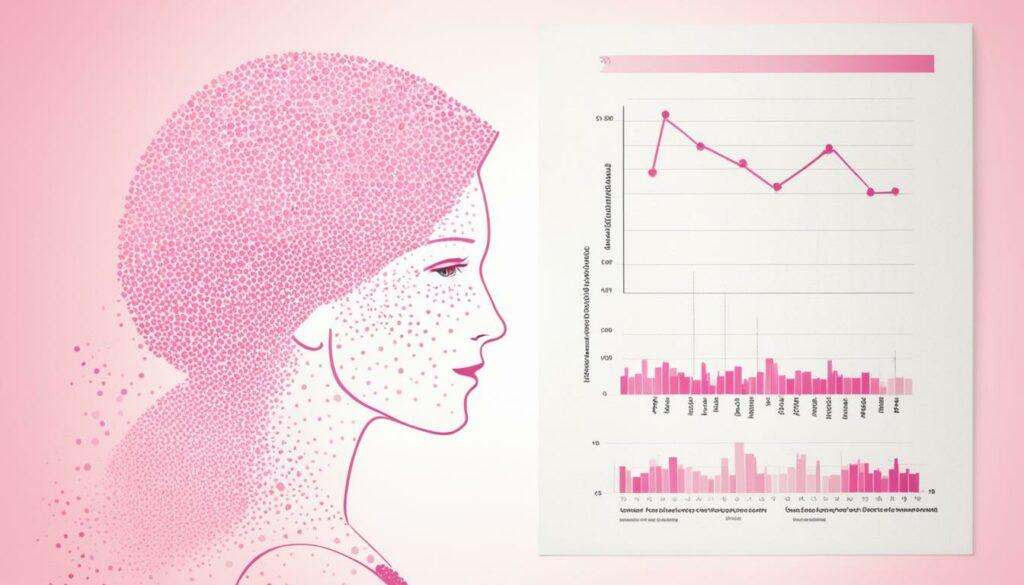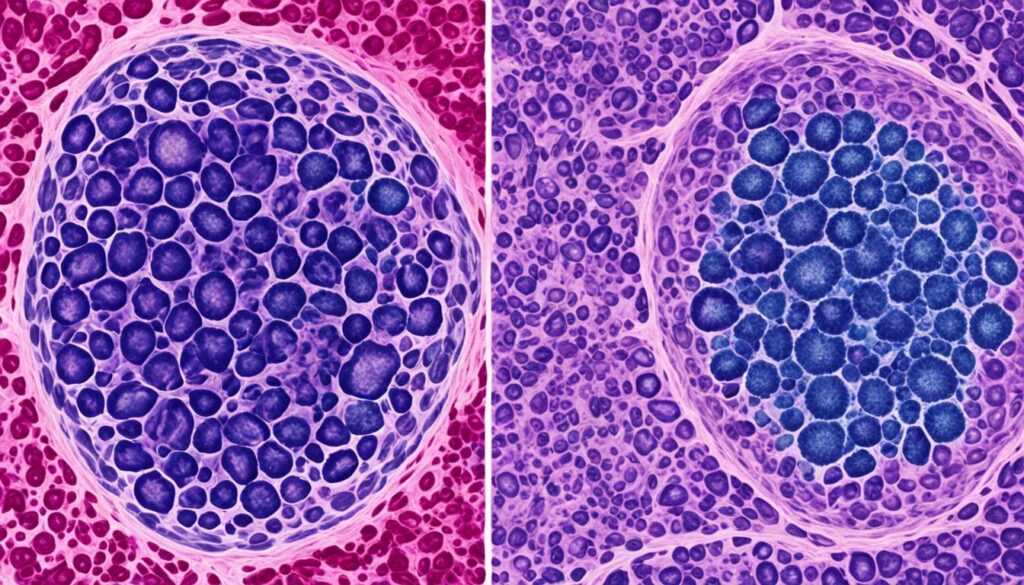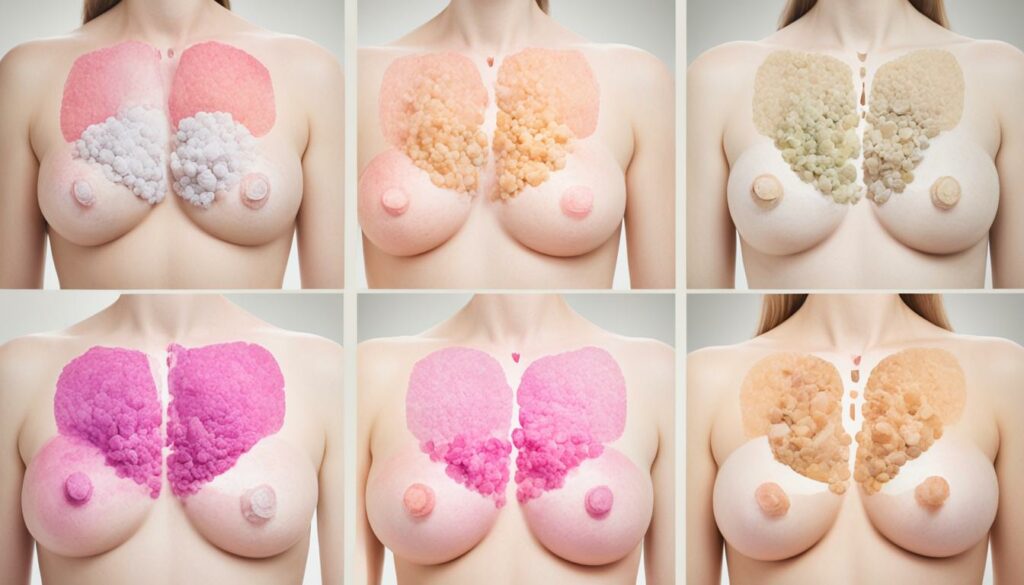Can Teens Get Breast Cancer? Risks & Facts Explained
When it comes to breast cancer, teenagers are typically not in the highest risk category. Breast cancer in teens is extremely rare, with an incidence rate of only 0.1 in 100,000. This means that out of every 1 million teens, there is only one case of breast cancer.
For girls aged 14 and younger, breast cancer is almost unheard of. As girls move through their teenage years, the chances increase slightly, but it remains a very rare occurrence. Despite the low risk, it’s important for teenagers to be aware of their breast health and understand the potential risks.
Key Takeaways:
- Breast cancer in teens is extremely rare, with an incidence rate of only 0.1 in 100,000.
- Girls aged 14 and younger have an almost nonexistent risk of breast cancer.
- As girls move through their teenage years, the chances of breast cancer increase slightly.
- Despite the low risk, it’s important for teenagers to be aware of their breast health.
- Regular breast self-exams and consulting a healthcare professional if any changes are noticed can help with early detection.
Symptoms of Breast Cancer in Teens

When it comes to breast cancer in teens, it’s essential to understand the symptoms that may indicate the presence of this rare condition. While breast cancer is incredibly uncommon in young adults, it’s still important to be aware of the early warning signs. Knowing what to look for can help teenagers and their caregivers take prompt action and seek medical attention if necessary.
Generally, breast cancer tumors in teens may feel different from normal breast lumps. Some indications that a lump may be cancerous include:
- Hardness: Cancerous lumps may feel firm or solid, rather than soft or spongy like benign lumps.
- Fixed position on the chest wall: Cancerous lumps may be fixed or attached to the chest wall and do not move easily when touched.
- Size ranging from the size of a pea to several inches: While not definitive, significant size variation in a lump can be a potential sign of cancer.
- Possible pain: Although it is important to note that not all breast cancers cause pain, discomfort or tenderness in the breast can be a symptom to be aware of.
It’s important to remember that symptoms such as nipple discharge and nipple inversion, where the nipple turns inward, are not very common in teens with breast cancer.
Being vigilant about any changes in the breasts and reporting any unusual symptoms to a healthcare professional is crucial. While breast cancer is rare in teenagers, early detection remains crucial for better treatment outcomes. If you or someone you know experiences any concerning symptoms, don’t hesitate to seek medical advice.
Causes of Breast Cancer in Teens

The exact causes of breast cancer in teens are still unclear due to the rarity of the disease. However, it is believed that childhood cancers, including breast cancer, can develop due to changes in cells and DNA that occur early in life, including during fetal development.
While research is ongoing, several factors may contribute to the development of breast cancer in teens:
- Genetic mutations: In some cases, changes in certain genes, such as BRCA1 and BRCA2, can increase the risk of breast cancer. These gene mutations can be inherited from a parent, but they can also occur spontaneously.
- Hormonal changes: Hormonal changes during puberty and the menstrual cycle can impact breast tissue and potentially lead to the development of cancerous cells.
- Exposure to radiation: Previous radiation treatments, such as those used to treat other types of cancer, can increase the risk of developing breast cancer later in life.
- Family history: Having a close relative, such as a mother or sister, who has been diagnosed with breast cancer can slightly increase the risk for teens. However, it’s important to note that the majority of breast cancer cases in teens occur in individuals with no family history of the disease.
“While the exact causes of breast cancer in teens are still being researched, genetic mutations, hormonal changes, exposure to radiation, and family history are believed to play a role.”
It’s important to note that environmental and lifestyle factors, such as smoking and diet, are not strongly associated with breast cancer development in teens. While healthy behaviors can positively impact overall health and well-being, the focus on reducing breast cancer risk in teens is primarily on understanding genetic factors and early detection through regular breast exams.
To learn more about the risk factors and causes of breast cancer in teens, consult the first source listed below.
| Contributing Factors | Description |
|---|---|
| Genetic Mutations | Inherited or spontaneous changes in genes like BRCA1 and BRCA2. |
| Hormonal Changes | Puberty and menstrual cycle-related hormonal fluctuations affecting breast tissue. |
| Exposure to Radiation | Prior radiation treatments increasing the risk of breast cancer. |
| Family History | Having a close relative with breast cancer slightly increases the risk in teens. |
Breast Cancer and Birth Control

Research suggests that hormonal birth control may slightly increase the risk of breast cancer. However, once a person stops using hormonal birth control, the risk levels eventually return to normal. It’s important to note that teens who use hormonal birth control have a low overall risk of developing breast cancer.
If you’re a teen considering birth control, it’s crucial to discuss your options with your doctor before making any decisions. They can provide personalized advice based on your medical history and individual circumstances. Remember, your doctor is there to support and guide you in making informed choices about your sexual and reproductive health.
While hormonal birth control may have some potential risks, it also offers significant benefits, such as preventing unplanned pregnancies and managing menstrual symptoms. It’s essential to weigh the potential risks against the benefits and make a decision that aligns with your healthcare goals.
“Discuss your birth control options with your doctor to make an informed decision about your sexual and reproductive health.”
It’s important to stay informed and educated about breast cancer risk factors, regardless of whether you’re using birth control or not. Understanding your own body and being diligent about breast self-exams can help detect any changes early on. Early detection is key in improving treatment outcomes for breast cancer.
Fact Box: Key Points
- Hormonal birth control may slightly increase the risk of breast cancer.
- Risk levels return to normal once a person stops using hormonal birth control.
- Teens who use hormonal birth control have a low overall risk of developing breast cancer.
- Discuss birth control options with your doctor to make an informed decision about your sexual and reproductive health.
- Stay informed about breast cancer risk factors and practice regular breast self-exams.
Breast Cancer vs. Normal Breast Development

During puberty, breasts undergo development and changes due to the release of specific hormones. It’s normal for teens to experience breast buds, which are raised bumps under the nipple, as the first sign of breast development. Lumps and tenderness in the breasts are common during this period and are usually part of normal breast development.
These lumps are called fibrocystic changes and are typically harmless. They are caused by hormonal fluctuations and can vary in size and sensitivity. It’s important for teens to understand that these changes are generally not associated with breast cancer.
While breast cancer can occur at any age, it is extremely rare in teens. When breast cancer does occur in adolescents, it often presents with different characteristics compared to the majority of breast cancer cases in older individuals.
It’s essential for teens and their parents to be aware of these normal breast changes during puberty to alleviate unnecessary worry or concern. However, if there is a specific lump or change that is causing distress or seems out of the ordinary, it’s always best to consult a healthcare professional for further evaluation.
Types of Breast Lumps in Teens

When it comes to breast lumps in teenagers, it’s important to understand that not all lumps are a cause for concern. Most breast lumps in teens are benign (noncancerous) and can be attributed to normal breast development. However, it’s essential to be aware of the different types of breast lumps that can occur in this age group.
The most common type of breast lump found in teenagers is fibroadenomas. These are noncancerous growths that can feel like solid, smooth, or rubbery lumps. Fibroadenomas are typically painless, movable, and have well-defined borders.
Other less common types of breast lumps in teens include:
- Cysts: Fluid-filled sacs that may feel tender or painful
- Lumps caused by injury: Trauma to the breast tissue can result in localized swelling or lumps
While breast cancer is extremely rare in teens, one type that can occur is secretory adenocarcinoma. This type of breast cancer is typically slow-growing and nonaggressive, but it is crucial to consult a healthcare professional if a lump causes discomfort or worry.
If you have concerns about a breast lump or experience any changes in your breasts, it’s always best to seek medical advice. A healthcare professional can perform a thorough evaluation and determine the appropriate course of action.
Types of Breast Lumps in Teens
| Type of Breast Lump | Description | Characteristics |
|---|---|---|
| Fibroadenomas | Noncancerous growths | Smooth, solid, movable, well-defined borders |
| Cysts | Fluid-filled sacs | Tender, painful |
| Lumps caused by injury | Result from trauma to the breast tissue | Localized swelling or lumps |
| Secretory adenocarcinoma | Rare form of breast cancer | Slow-growing, nonaggressive |
Diagnosing Breast Cancer in Teens

When a teenager detects anything unusual in their breast, it is essential to consult a healthcare professional for a thorough examination and diagnosis. The diagnosing process typically involves various assessments and tests to evaluate the nature of the lump and determine if breast cancer is present.
Medical History and Physical Examination
During the initial consultation, the doctor will inquire about the teenager’s family medical history, including any instances of breast cancer. They will also ask specific questions regarding the lump, such as when it was discovered, the presence of nipple discharge, and any associated pain. These details help in better understanding the situation and making an accurate diagnosis.
Imaging Tests
If necessary, the doctor may order an imaging test to further investigate the lump. An ultrasound is commonly used to assess the lump’s characteristics and determine its composition—whether it is solid or fluid-filled. This non-invasive procedure provides valuable information to aid in the diagnostic process.
Fine Needle Biopsy
In some cases, a fine needle biopsy may be performed to extract a small sample of tissue from the lump. This sample is then analyzed in a laboratory to determine if cancer cells are present. A fine needle biopsy is a minimally invasive procedure that offers valuable insights into the nature of the lump and helps guide treatment decisions.
Mammograms and Breast Cancer Screening
Mammograms, which involve breast imaging using X-rays, are not typically recommended for teenagers unless they exhibit high-risk factors or present specific symptoms. Breast cancer screening guidelines may vary based on age and individual circumstances, so it is crucial to follow the recommendations provided by healthcare professionals.
Early detection plays a critical role in effectively managing breast cancer, even though it is rare in teens. Seeking prompt medical attention and undergoing the necessary diagnostic procedures can help ensure timely intervention and appropriate treatment, leading to the best possible outcomes.
Treatment of Breast Cancer in Teens
The treatment of breast cancer in teens usually involves surgical removal of the cancerous tissue while preserving as much breast tissue as possible. This approach aims to effectively eradicate the cancer while minimizing the impact on the individual’s body image and overall well-being. Surgical options for teen breast cancer patients include lumpectomy, where only the tumor and a small portion of surrounding tissue are removed, and mastectomy, which involves the complete removal of the breast.
Chemotherapy and radiation may be considered as adjuvant therapies after surgery, depending on the type and stage of the cancer. However, these treatment modalities are carefully evaluated on a case-by-case basis, taking into account the potential risks they pose to young, developing bodies. The medical team will assess the benefits of these treatments in relation to the specific circumstances of the individual.
“Our goal is to provide the most effective treatment plan for teen breast cancer patients while considering their unique physiological and emotional needs. By tailoring the treatment approach, we aim to achieve the best possible outcomes and preserve the quality of life for these young individuals.”
It is essential for teens diagnosed with breast cancer to have ongoing follow-up care, which may include regular check-ups, imaging tests, and blood work to monitor their health and detect any potential recurrence or complications. The medical team will work closely with the patients and their families to provide comprehensive support throughout the treatment journey.
Noticing Changes and Breast Exams
The American Cancer Society (ACS) no longer recommends routine breast self-exams as there is no evidence that they reduce breast cancer deaths. However, it is important for individuals to be familiar with their breasts and take note of any changes, such as lumps, thickness, discharge, abnormalities, or skin changes.
While routine self-exams may not be necessary, being aware of breast changes is crucial. By regularly checking their breasts, teenagers can detect any unusual changes and seek medical attention if needed. It’s important to remember that most breast changes in teens are due to normal development, but it’s always better to be safe and seek professional advice.
Clinical breast exams are also rare in teens, but if there are concerns or symptoms, a healthcare provider may perform an exam. This can help determine the nature of any changes and guide further diagnostic steps if necessary.
“Being familiar with your breasts is important at any age. If you notice any changes that concern you, it’s always best to consult with a healthcare professional.” – Dr. Emily Thompson, Pediatric Oncologist
Additionally, teenagers can reduce their risk of breast cancer by adopting a healthy lifestyle. Regular exercise, maintaining a healthy weight, and avoiding smoking are all beneficial habits that can contribute to overall wellbeing, including breast health.
Understanding Breast Changes
During puberty, breasts undergo significant changes as part of normal development. It’s common for teens to experience breast tenderness, lumpiness, or asymmetry. These changes are generally harmless, but it’s important to be aware of any differences or abnormalities.
Here are some common breast changes that teenage girls may experience:
- Breast buds: Small raised bumps under the nipple that are the first sign of breast development
- Lumpiness: The breast tissue may feel lumpy or uneven, especially near the armpit
- Larger size: breasts gradually grow and increase in size
- Sensitivity: the breasts may feel tender or sensitive, especially during the menstrual cycle
If any changes cause concern or discomfort, it’s important for teenagers to discuss them with a healthcare professional. While most breast changes are normal, it’s always better to be cautious and seek medical advice to ensure peace of mind.
Conclusion
While breast cancer is extremely rare in teens, it’s crucial for young individuals to prioritize their breast health and be proactive in seeking medical attention if they notice any changes or have concerns. Early detection plays a vital role in the rare cases of teen breast cancer, and prompt action can lead to better outcomes. By staying aware and vigilant, teenagers can take control of their health and potentially save their lives.
In addition to regular check-ups, fostering breast cancer awareness among teenagers is essential. Educating young individuals about the basics of breast health, including self-exams and understanding what is normal and what may be concerning, can empower them to take charge of their well-being. Knowledge is a powerful tool in early detection, and it is never too early to start building a foundation of breast health awareness.
Furthermore, maintaining a healthy lifestyle can reduce the risk of breast cancer later in life. Engaging in regular physical activity, maintaining a healthy weight, and avoiding smoking are all proactive steps that can contribute to overall well-being and potentially decrease the risk of breast cancer. Encouraging teenagers to adopt these healthy habits is an investment in their future health.
While breast cancer may be rare in teens, it is essential to promote breast cancer awareness and empower young individuals to prioritize their breast health. By taking these small but significant steps, we can contribute to a future where breast cancer is better understood, diagnosed early, and ultimately, prevented.
FAQ
Can teens get breast cancer?
Breast cancer is extremely rare in teenagers, with an incidence rate of only 0.1 in 100,000. While the chances of breast cancer increase slightly as girls move through their teenage years, it remains very rare.
What are the symptoms of breast cancer in teens?
Breast cancer tumors in teens can feel different from normal breast lumps. Some indications that a lump may be cancerous include hardness, fixed position on the chest wall, size ranging from the size of a pea to several inches, and possible pain. However, symptoms such as nipple discharge and nipple inversion are not very common in teens with breast cancer.
What causes breast cancer in teens?
The exact causes of breast cancer in teens are still unclear due to the rarity of the disease. However, it is believed that childhood cancers, including breast cancer, can develop due to changes in cells and DNA that occur early in life, including during fetal development.
Is there a link between breast cancer and birth control in teens?
Some research suggests that taking hormonal birth control slightly increases the risk of breast cancer, but once a person stops using hormonal birth control, the risk levels eventually return to normal. Teens who use hormonal birth control have a low overall risk of developing breast cancer.
How does breast cancer differ from normal breast development during puberty?
During puberty, it’s normal for teens to experience breast buds, which are raised bumps under the nipple, as the first sign of breast development. Lumps and tenderness in the breasts are common during this period and are usually part of normal breast development.
What types of breast lumps are common in teens?
The most common type of breast cancer found in teens is secretory adenocarcinoma, which is generally a slow-growing and nonaggressive cancer. However, fibroadenomas, which are noncancerous lumps, are the most common breast mass in teenage girls. Other less common lumps include cysts and lumps caused by injury to the breast tissue.
How is breast cancer diagnosed in teens?
If a teenager feels anything unusual in their breast, a doctor will typically ask about family medical history, when the lump was discovered, the presence of nipple discharge, and any pain associated with the lump. If necessary, an ultrasound may be performed to determine whether the lump is solid or fluid-filled. A fine needle biopsy may also be conducted to test the tissue for cancer.
How is breast cancer treated in teens?
The treatment of breast cancer in teens usually involves surgical removal of the cancerous tissue while preserving as much breast tissue as possible. Chemotherapy and radiation may be considered on a case-by-case basis, taking into account the risks these treatments pose to young, developing bodies.
How should teens notice changes in their breasts and perform breast exams?
While the American Cancer Society no longer recommends routine breast self-exams for teens, it is important for individuals to be familiar with their breasts and take note of any changes, such as lumps, thickness, discharge, abnormalities, or skin changes. Clinical breast exams are also rare in teens, but if there are concerns or symptoms, a healthcare provider may perform an exam.
Should teens be concerned about breast cancer?
While breast cancer is extremely rare in teens, it’s important for young individuals to be aware of their breast health and to consult a healthcare professional if they notice any changes or have concerns. Early detection is crucial in the rare cases of teen breast cancer. Additionally, adopting healthy lifestyle habits such as maintaining a healthy weight, exercising regularly, and avoiding smoking can help reduce the risk of breast cancer later in life.







